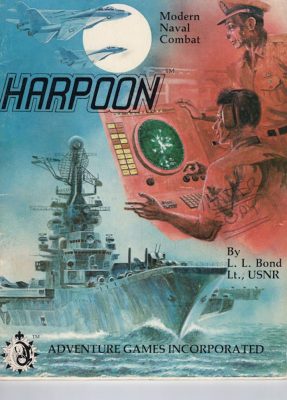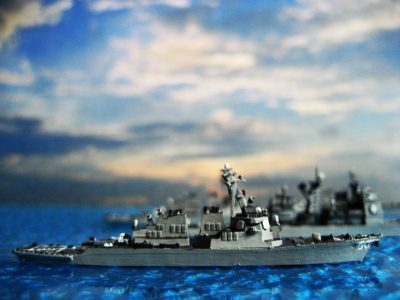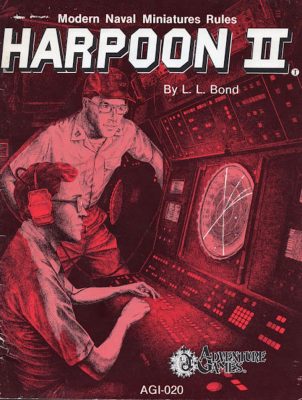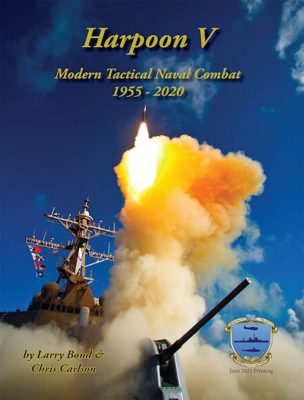Retrospective of Harpoon, the Tabletop Game
 By Patrick S. Baker
By Patrick S. Baker
The Personal Computer version of Harpoon was released for the DOS operating system in 1989 by Three-Sixty Pacific and it took the gaming world by (Red) Storm (Rising). The naval simulation received raved reviews and I, like many other military officers and others interested in modern naval warfare, rushed out to buy the game. I even invested in an upgraded computer to play it.
At that point, I had no idea that the marvelous game I spent literally days playing was based on a tabletop and miniatures game. But everything comes from something else and Harpoon was no exception. Indeed, the game did not spring Athena-like from Larry Bond’s head.
According to , the then twenty-four-year-old Naval Lieutenant Junior Grade Larry Bond, encountered the US Navy’s official computer wargame, NAVal TActical Game (NAVTAG) in 1976. NAVTAG was the digitized successor to the manual pen and paper SEA control Tactical Analysis Game (SEATAG). NAVTAG only came in a classified version and took three computers to play, limiting its utility.

According to retroviator.com, Bond thought he could do better and decided to create an “all-purpose air, surface, and submarine simulation accessible to the general public.” Using unclassified sources, Bond developed the rules and did the various calculations for what would become Harpoon, then Bond wrote up the original game “in a week”. Then he and his shipmates play-tested it for the next two years while assigned to the destroyer, USS McKean.
Once off active duty, Bond contacted Adventure Games, Inc to publish the game.  They published Harpoon in 1981. The game received the H.G. Wells Award for Best Miniatures Game of 1981. Sold without accompanying miniatures, it could be played with just pencil and graph paper. One commenter said the game was best played on paper, because unless you had a playing area the size of a football stadium, all the player did was change which way the miniatures pointed.
They published Harpoon in 1981. The game received the H.G. Wells Award for Best Miniatures Game of 1981. Sold without accompanying miniatures, it could be played with just pencil and graph paper. One commenter said the game was best played on paper, because unless you had a playing area the size of a football stadium, all the player did was change which way the miniatures pointed.
According to Bond in a 2013 interview, Harpoon was one of Tom Clancy’s sources for his bestselling 1984 novel, The Hunt for Red October. Clancy and Bond started a correspondence about the game and the book and became fast friends. Harpoon was also used as a source for the 1986 bestseller Red Storm Rising, co-authored by Bond and Clancy.
According to the Admiralty Trilogy website, Harpoon’s second edition appeared in 1983 with improved and expanded modeling, based on the naval and air battles of the Falklands War. Sadly, soon after its release the publisher, Adventure Games, Inc., went out of business.
The franchise now moved to Game Designers’ Workshop (GDW) which put out the third edition in 1987. This version shifted from playing with miniatures to playing with generic cardboard counters. The third edition also won the H.G. Wells Award.
The boardgamegeek.com website states that in 1990 GDW published Harpoon: The Captain’s Edition, a traditional board game with non-generic cardboard counters and an 18 x 21 hexagonal grid map depicting the North Atlantic’s Greenland, Iceland, United Kingdom gap. Called “a simpler version of the original Harpoon” it was designed for novice players. The box said: “Start Playing in 30 Minutes.” This version was popular among more casual gamers. 
GDW went out of business and Clash of Arms (CoA) took over the franchise. CoA published the fourth edition in 1996. The games came with non-generic cardboard counters, but no maps, and it was recommended that the game be played on a large, flat surface This edition won the 1996 Origins Awards for Best Modern-Day Board Game. CoA also supported the game with scenario and annex books and went on to publish a revised rule book, called Version 4.1, in 2001.
Bond and his collaborator, Chris Carlson, took back control of the Harpoon intellectual property from COA and established the Admiralty Trilogy Group (ATG) to publish Harpoon and other naval wargames. Harpoon V was published in 2020 by ATG and returns to Harpoon’s roots, being a game system rule book and supporting documents.
The fifth edition delivers a simplified game playing system while updating the game for 21st Century naval warfare by adding weapons systems like anti-ship ballistic missiles, ballistic missile defense, and drones.
At the time of this writing, Bond and Carlson plan on continuing to revise and extend the Harpoon gaming system into the foreseeable future.
Patrick S. Baker is a former US Army Field Artillery officer and retired Department of Defense employee. He has degrees in History, Political Science and Education. He has been writing history, game reviews and science-fiction professionally since 2013. Some of his other work can find some at , Lorelei Signal and .

Great overview. I was a big fan of Harpoon II back in the day. Played it with 1/3000 scale models. Used paper and math for representation between battle groups and then each battle group had its own table to set up on.
“Clash of Arms folded and Bond and his collaborator, Chris Carlson, took back control of the Harpoon intellectual property.”
Clash of Arms is still in business though.
https://www.clashofarms.com/
Great overview, but one small correction. Clash of Arms didn’t fold. Its still publishing wargames, just not the Admiralty Trilogy.
As far as I am aware, Clash of Arms is still functioning as a company.